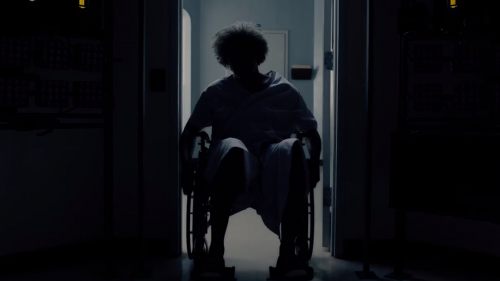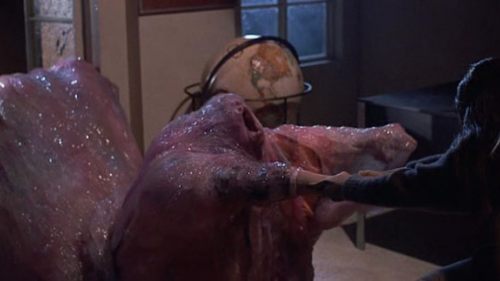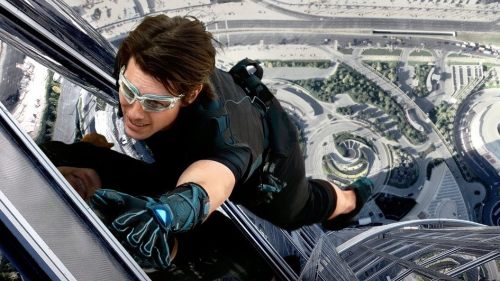Sunday Reads: Reconsidering GHOSTS OF MARS
John Carpenter was not in a good place in 2001. He’d spent the last decade releasing one bomb after another (to be fair, even many of his '80s cult favorites failed to light the box office on fire), and the '90s were as unkind to him as it was to many of his peers. 1995′s In The Mouth Of Madness and 1998′s Vampires have vocal fanbases today, but the decade was mostly a wash for the iconic director, and he seemed to know it, turning up for checks and lampooning himself in things like Body Bags. We all made the “hey, the guy’s entitled to make a living” rationalizations, but if you grew up during Carpenter’s “glory days”, sitting in the theater as Escape from LA unspooled was not unlike watching your dad get beat up by a neighbor.
By the time Ghosts of Mars showed up in 2001, everyone was ready to call time of death on Carpenter’s career, and the movie – quaint, cheap, a little out of touch – couldn’t compete with all the Lords of the Rings and Blackhawks Down and Donnie Darkos released that year. It felt as if maybe the medium had passed him by. But something happened to the film - or maybe just to my perspective of it - in the 16 years since it was released. As a catalog title, Ghosts Of Mars is no longer in competition with its peers, and within the context of “older John Carpenter film” I was surprised to discover how well the film actually fits into Carpenter’s body of work. It feels like a John Carpenter Film™; it makes sense in his canon, taking his fetishism of Howard Hawks further than ever. And despite the criticisms that the film is Carpenter treading old ground, there IS growth here; it’s just that he’s growing in a direction his hardcore fans might not prefer.
Dismissed by fans and critics as Carpenter remaking Hawks’ Rio Bravo yet again (after 1976′s Assault on Precinct 13), there’s no denying that the film does indeed find Carpenter wallowing in the most Hawksian of setups: a team of law enforcers are traversing the landscape (by train, no less) to transport a dangerous criminal, “Desolation” Williams (Ice Cube, dressed more than a bit like Snake Plissken, down to the sleeveless black shirt and Mars-red camouflage pants). Shaking things up a bit, Carpenter sets the film against the backdrop of a matriarchal society. Pam Grier is the badass-in-charge, with Natasha Henstridge playing Ballard, her drug-addicted second-in-command. Clea Duvall plays the rookie, and lasts quite a while for someone who is essentially cannon fodder, while a young Jason Statham has fun as the willing sex object in this female-run society. (Supporting player Robert Carradine seems to exist only to cheerfully serve coffee, a great/goofy jab at the original The Thing from Another World.) Once they reach the frontier town holding their prisoner, they discover their caged quarry, as well as the aftermath of a massacre, leading to a series of stand-offs and battles with a group of miners possessed by savage indigenous spirits who want the humans off their land. It’s Carpenter doing what he seems to love best: throwback action heroes in full-on siege mode. Ten years on, the action is clean and well-rendered, an almost refreshing change from the “chaos cinema” with which we’ve been bombarded for the past decade.
But is the movie actually any good, or am I just getting more clear-eyed about Carpenter’s “great” works, and realizing this movie isn’t as much of an aberration as folks thought it was 16 years ago? The truth is probably somewhere in the middle. Carpenter’s early successes are often celebrated as triumphs of scrappy ingenuity overcoming budgetary limitations, and over the years a certain demographic (guilty) inflated those successes to “masterpiece” status; sometimes warranted, sometimes not. From 1978′s Halloween to 1988′s They Live, a new John Carpenter film was something to get excited about. While in reality those films varied pretty wildly in quality, we grew up considering that period his “golden age,” and to his fans, the films from that period are nigh-untouchable. By 2001, we were expecting/hoping for that same rush from Carpenter, and not getting it. But whose fault is that, exactly? Although the film can’t help but look low-rent next to the films which opened alongside it, today it feels as if Carpenter got a raw deal for simply making another John Carpenter movie.
Make no mistake, the film has problems: Henstridge’s Ballard is the most self-assured, capable and clear-eyed drug addict I’ve ever seen (it’s worth noting that Courtney Love was originally chosen for this role); the flashback-within-a-flashback structure of the film quickly reaches self-parody, the screen dissolving over and over as a character in someone's story starts to tell another story; and ill-advised POV shots serve as scotch tape coverage over a sequence or two. The model work looks like model work, which is a negative for some, but something I find sort of charming. But worst of all, Carpenter’s fun, very Carpenter-esque score is often overshadowed by metal riffs provided by the likes of Anthrax, Buckethead, and Steve Vai. But ultimately Ghosts Of Mars is a fairly traditional action piece with more classic Carpenter elements than I’d remembered. And God help me the day I start thinking Escape from LA “isn’t that bad,” but aside from impatient editing which feels as if it’s trying to hurry through a longer, potentially better film – lap dissolves, transitional dissolves, and vertical, diagonal and circle wipes are all used and abused – you can’t fairly call this film any clunkier than, say, Prince Of Darkness. It maybe isn’t a very good movie at the end of the day but, all things considered, it’s not a terrible John Carpenter movie.
With that said, is Carpenter bringing anything new to the table? Yes and no. In 1982, Carpenter appropriated the Hawks model for his reworking of The Thing, but what was great about that swipe was the director turning the scenario on its ear – where Hawks’ original film had men pulling together to fight the alien invader, in Carpenter’s film the enemy turned us humans against ourselves. It was homage but with a new layer, a clever and resonant subversion of Hawks’ themes, and the tweaking of that theme is, to me, the central reason for the film’s enduring reputation. But in Ghosts Of Mars Carpenter’s added layer is that there IS no added layer. The director trades subversion and irony for outright duplication: Carpenter’s ghost Martians (literal red clouds of dust) are directly descended from the cinematic stereotype of the savage redskins – sub-human, bloodthirsty, and incapable of reason. The heroes and villains of this film quickly and willingly band together, first to defend themselves from, and ultimately to exterminate, this horrible Other. The movie might be set in 2176, but as far as Carpenter is concerned he’s making a 1940s Western. He’s smuggling some of the most outdated, politically incorrect shit into this movie, and probably smirking about it the entire time.
Carpenter lets his humans off the hook somewhat, since the tribal squatters are technically “ghosts.” But despite the title, this is a science fiction film, not a supernatural one, and the truth is these incorporeal beings are legitimate, quantifiable life forms defending their home turf from invaders. And they’re given all the consideration of a stock group of painted-up extras circa 1947. I was almost surprised the heroes didn’t ultimately defeat the ghosts with Martian smallpox and space liquor. It’s telling and a little chilling that Carpenter sums up his protagonists’ position with the simple (and simplistic) line, “This is about one thing: dominion. It’s not their planet anymore.” John Wayne couldn’t have said it better himself.
If Carpenter’s career arc was about wanting to recreate those westerns he loved from his childhood, Ghosts Of Mars has to be recognized as the director at his most self-actualized. He’s not only got the plot and conventions of his beloved old films down pat; in this film, he’s openly adopted their antiquated attitudes. One has to wonder if he was pissed that no one seemed to have noticed.
A version of this article was originally published in 2011.



